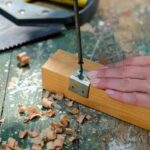Woodworking is an ancient art that requires the use of different types of joints to create strong and durable structures. Understanding the various woodworking joints is essential for woodworkers, as it directly impacts the strength and longevity of their projects. The question on many woodworker’s minds is – what is the strongest woodworking joint?
In this article, we will delve into the world of woodworking joints, providing an overview of the different types and discussing the factors that contribute to their strength. We will explore classic joints such as mortise and tenon, dovetail, dowel, and box joints, evaluating their individual strengths and weaknesses.
By understanding the strength and durability of each type of joint, woodworkers will be better equipped to choose the right one for their specific projects. Whether it’s crafting a sturdy cabinet or constructing a robust piece of furniture, knowing which joint offers optimal strength can make all the difference in creating long-lasting and reliable wooden creations.
So let’s embark on this journey through the world of woodworking joints to unravel which one reigns supreme in terms of strength.
Overview of Woodworking Joints
Woodworking joints are a crucial aspect of any woodworking project, as they determine the strength and durability of the final piece. Understanding the different types of woodworking joints is essential for woodworkers, as it allows them to choose the most suitable joint for their specific project.
There are several factors that contribute to the strength of a woodworking joint, such as the type of wood used, the angle of the joint, and the method of joint construction. In this section, we will provide an overview of some common woodworking joints, including simple joints like butt joints and more complex joints like dovetail joints.
Butt Joints
One of the simplest and most basic woodworking joints is the butt joint, where one piece of wood is joined directly to another at a right angle. While easy to construct, butt joints are not necessarily known for their strength, as they rely heavily on glue or nails to hold the pieces together. However, reinforcing a butt joint with dowels or splines can increase its strength significantly.
Half-Lap Joints
Half-lap joints are another simple but effective type of woodworking joint that involves cutting away half the thickness of each piece so that they overlap each other. This creates a large gluing area and results in a strong joint when done correctly. Half-lap joints are commonly used in building frames and shelving.
Dovetail Joints
Dovetail joints are widely regarded as one of the strongest woodworking joints due to their interlocking design and resistance to pulling forces. This type of joint is commonly used in drawer construction, cabinetry, and fine furniture making due to its superior strength and aesthetic appeal. Mastering dovetail joinery requires precision and skill but yields exceptional results in terms of both strength and visual appeal.
By understanding the strengths and weaknesses of each type of woodworking joint, woodworkers can make informed decisions about which joint to use based on their specific project requirements. The next sections will delve deeper into some popular woodworking joints like mortise and tenon joints, dovetail joints, dowel joints, and box joints to provide a more detailed examination into their individual strengths and applications within woodworking projects.
Strength Factors
When it comes to woodworking, understanding different types of joints is crucial for creating strong and durable pieces. The strength of a woodworking joint is influenced by several factors, including the type of wood used, the angle of the joint, and the method of joint construction. Woodworkers must carefully consider these factors when selecting and creating joints to ensure their projects are structurally sound.
- Type of Wood: Different types of wood possess varying levels of strength and durability. Hardwoods such as oak, maple, and mahogany are known for their strength and are commonly used for creating strong woodworking joints. Softwoods like pine or cedar may be more prone to splitting or wear over time.
- Angle of Joint: The angle at which two pieces of wood meet in a joint can significantly impact its strength. For example, an angled joint may offer more resistance to pulling forces than a straight joint due to how it distributes weight and pressure across the joint.
- Method of Joint Construction: The way in which a joint is constructed plays a vital role in its overall strength. Some methods, such as using adhesive or mechanical fasteners like screws or nails, can enhance the joint’s stability. However, traditional joinery techniques that rely on interlocking components often yield some of the strongest woodworking joints available.
Mortise and Tenon Joints
When it comes to woodworking joints, few are as durable and reliable as the mortise and tenon joint. This classic joint has been used for centuries and is known for its strength and stability.
The construction of a mortise and tenon joint involves two main components: the mortise, which is a cavity or hole, and the tenon, which is a protruding piece of wood that fits into the mortise. This design creates an incredibly strong connection between two pieces of wood.
Types of Mortise and Tenon Joints
There are several variations of the mortise and tenon joint, each with its own unique qualities that make it suitable for different woodworking projects. These include through, stopped, wedged, haunched, shouldered, angled, tusked, and mitered mortise and tenon joints. Each type offers specific advantages in terms of strength, durability, and aesthetics.
The strength of a mortise and tenon joint lies in its design. When constructed properly, this joint can withstand significant forces without coming apart. Additionally, the larger glue surface area provided by this joint compared to others like dowel joints or butt joints enhances its durability even further. For these reasons, the mortise and tenon joint remains a top choice for woodworkers who prioritize strength when selecting joinery methods.
Dovetail Joints
When it comes to woodworking joints, one of the most renowned for its strength and durability is the dovetail joint. The dovetail joint is known for its interlocking design, which provides exceptional resistance to pulling forces. This makes it an ideal choice for creating drawers, cabinets, and other woodworking projects that require a secure and long-lasting joint.
The unique shape of the dovetail joint consists of a series of pins and tails that interlock to create a joint that is incredibly resistant to being pulled apart. This strong interlocking design is what makes dovetail joints so effective at providing stability and preventing warping or racking in furniture pieces.
In addition to its impressive strength, dovetail joints also offer an attractive aesthetic. The visible tails on one piece of wood and pins on another create a visually striking pattern when assembled, adding a decorative element to the joint. This combination of strength and visual appeal has made dovetail joints a popular choice among woodworkers for centuries.
| Strengths | Considerations |
|---|---|
| Exceptional resistance to pulling forces | Requires precision in cutting to ensure proper fit |
| Provides stability and prevents warping | Can be more time-consuming to create compared to other joints |
| Adds an attractive visual element to woodworking projects | May be challenging for beginners due to complexity |
Dowel Joints
Dowel joints are a popular method of joining two pieces of wood together. This simple yet effective woodworking joint relies on wooden pins, known as dowels, to hold the pieces in place. The strength of a dowel joint is achieved through the precision of the drilling and alignment of the holes for the dowels. When properly constructed, dowel joints can provide a strong and durable connection between wood pieces.
One of the key factors that contribute to the strength of a dowel joint is the type of wood used for construction. Hardwoods such as oak, maple, or cherry are preferred for their density and resistance to splitting, which enhances the overall strength of the joint. Additionally, the angle and depth at which the holes are drilled play a crucial role in determining the strength and stability of the joint.
In woodworking projects where mechanical fasteners such as screws or nails may not be suitable, dowel joints offer an aesthetically pleasing alternative that also provides sufficient strength. The simplicity and versatility of dowel joints make them an essential technique for woodworkers seeking strong and reliable joinery solutions for their projects.
Box Joint
The box joint is a type of woodworking joint known for its strength and durability. It is commonly used in cabinet making and other woodworking projects that require a strong, secure joint. This type of joint is created by interlocking the fingers of two pieces of wood at right angles. The result is a sturdy and reliable joint that can withstand heavy loads and forces.
One of the key factors that contribute to the strength of a box joint is the large gluing surface it provides. The interlocking fingers create numerous contact points for glue, ensuring a strong bond between the two pieces of wood. Additionally, the large surface area makes it less likely for the joint to separate under pressure, making it an ideal choice for projects that require maximum strength and stability.
In terms of aesthetics, the box joint also offers a visually appealing look with its uniform and symmetrical pattern. This makes it a popular choice for visible joints in furniture making, as it adds a decorative element to the piece. Overall, when it comes to woodworking joints, the box joint is one of the strongest options available, making it suitable for a wide range of applications where strength and durability are essential.
| Woodworking Joint | Strength Rating (1-10) |
|---|---|
| Mortise and Tenon Joint | 9 |
| Dovetail Joint | 8 |
| Dowel Joint | 7 |
| Box Joint | 9 |
Conclusion
In conclusion, understanding the different types of woodworking joints is essential for woodworkers who are looking to create strong and durable projects. Whether it’s a simple butt joint or a more complex dovetail joint, knowing which joint to use for each specific project can make all the difference in the final product’s strength and stability.
Throughout this article, we have explored various woodworking joints and their individual strengths. From the reliable mortise and tenon joints to the interlocking design of dovetail joints, each type offers unique characteristics that make them suitable for different applications. Factors such as the type of wood used, the angle of the joint, and the method of construction all play a role in determining the strength of a woodworking joint.
When deciding which joint to use for a particular project, it is important to consider factors such as the intended use of the finished piece, the type of wood being used, and the desired aesthetic. For example, box joints are commonly used in cabinet making due to their strength and secure fit, while dovetail joints are often chosen for projects that require resistance to pulling forces.
By carefully considering these factors and understanding the strengths of each type of woodworking joint discussed in this article, woodworkers can ensure that their projects are built with optimal strength and durability.
Frequently Asked Questions
What Is the Weakest Joint in Woodworking?
The weakest joint in woodworking is typically considered to be the butt joint. This type of joint involves simply joining two pieces of wood together at their ends, without any additional support or interlocking. While butt joints are quick and easy to create, they are not very strong and can easily come apart under stress.
What Is the Most Complicated Woodworking Joint?
The most complicated woodworking joint is often seen as the dovetail joint. This type of joint requires precise cutting and fitting of two interlocking wedges, creating a strong connection between two pieces of wood. Dovetail joints are commonly used in high-quality furniture and cabinetry due to their strength and decorative appeal.
What Is the Strongest Joint in Timber Framing?
The strongest joint in timber framing is widely regarded as the mortise and tenon joint. This classic woodworking joint involves fitting a solid rectangular projection (the tenon) on one piece of wood into a square hole (the mortise) on another piece.
Mortise and tenon joints are known for their durability and ability to withstand heavy loads, making them a popular choice for constructing sturdy timber frames in buildings and other structures.

Hi everyone! I’m a woodworker and blogger, and this is my woodworking blog. In my blog, I share tips and tricks for woodworkers of all skill levels, as well as project ideas that you can try yourself.





